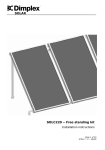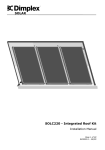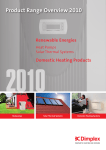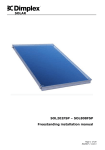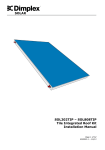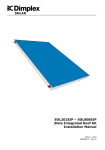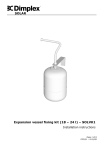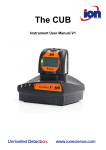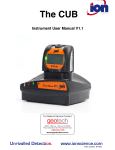Download Dimplex SOLAR ST0133 Technical data
Transcript
SOLAR Technical Manual Complete guide to Dimplex Solar Page 1 of 72 ST0133 – A 02/09 Technical manual SOLAR 1 Contents 1 CONTENTS 2 2 BEFORE YOU START 4 GENERAL 3 SOLAR THERMAL 3.1 INTRODUCTION 3.2 SOLAR RADIATION 3.1.1 Available solar radiation 3.1.2 Orientation 3.3 SOLAR THERMAL SYSTEM 3.3.1 Components of a solar thermal system 3.3.2 Function of a solar thermal system 4 DIMPLEX SOLAR PRODUCTS 4.1 DIMPLEX SOLAR COLLECTOR SOLC220 4.1.1 General description 4.1.2 Hydraulic collector connection 4.1.3 Roof fixing kits 4.1.4 Space requirement 4.1.4 Technical data 4.2 DIMPLEX SOLAR CONTROL UNIT SOLCU1/2/3 4.2.1 General description 4.2.2 Temperature sensors 4.2.3 Technical data 4.3 DIMPLEX SOLAR PUMP UNIT SOLPU1/2 4.3.1 General description 4.3.2 Pump connection 4.3.3 Technical data 4.4 DIMPLEX SOLAR EXPANSION VESSELS SOLEV 4.4.1 General description 4.4.2 Expansion vessel sizing 4.4.3 Technical data 4.5 DIMPLEX EXPANSION VESSEL FIXING KIT SOLVK1 4.5.1 General description 4.5.2 Technical data 4.6 DIMPLEX HEAT TRANSFER MEDIUM SOLHT20 4.6.1 General description 4.6.2 Technical data 4.7 DIMPLEX SOLAR CYLINDERS SCX 4.7.1 General description 4.7.2 Wiring integration Dimplex solar cylinders SCx 4.7.3 Hydraulic integration Dimplex solar cylinders SCx 4.7.4 Technical data 4 4 4 4 4 6 8 8 10 11 11 11 13 17 22 24 24 24 25 26 26 26 30 31 32 32 32 35 35 35 36 36 36 37 37 37 39 42 43 Page 2 of 72 ST0133 – A 02/09 Technical manual SOLAR 4.8 DIMPLEX SOLAR ACCESSORIES 4.8.1 General description 4.8.2 Corrugated flexible pipe SOLFH10/15 4.8.3 Feed through tiles SOLFTT and SOLFTM 5 SYSTEM SIZING 5.1 REQUIRED INFORMATION 5.2 SIZING GUIDE 6 PIPE WORK 6.1 TYPE OF PIPE WORK 6.2 PIPE WORK SIZING 6.3 PIPE WORK PRESSURE DROP 6.4 PIPE WORK LIQUID CONTENT 6.5 PIPE WORK FIXATION 6.6 PIPE WORK INSULATION 44 44 45 46 47 47 47 49 49 49 50 50 51 51 7 COMMISSIONING 52 8 OPERATION 53 8.1 CONTROL UNIT 8.2 PUMP UNIT 53 55 9 MAINTENANCE 55 10 PRODUCT AND KIT LISTINGS 58 10.1 DIMPLEX SOLAR KITS 10.2 DIMPLEX SOLAR COMPONENTS 58 58 11 DIMPLEX LITERATURE STRUCTURE 60 12 APPENDIX 61 12.1 ON SITE QUESTIONNAIRE 12.2 ON SITE INSPECTION 12.3 DIMPLEX SOLAR SYSTEM DIRECT – OVERALL VIEW 12.4 DIMPLEX SOLAR SYSTEM INDIRECT – OVERALL VIEW 12.5 EXAMPLE DIMPLEX SOLAR SIMULATION REPORT 13 NOTES AND SKETCHES 61 62 65 66 67 72 Page 3 of 72 ST0133 – A 02/09 Technical manual SOLAR 2 Before you start General Thank you for your interest in Dimplex Solar products. We trust this manual will give you all the answers to the questions that you might have regarding the products. Although every care was taken to ensure the content of this manual is correct we do not accept any liability for claims resulting directly or indirectly from the application of the information contained in this manual. This manual is written specifically for the Dimples Solar product range. Any information contained therein must not be applied generally to any other solar products. Should you require any further assistance please do not hesitate to contact us. 3 Solar thermal 3.1 Introduction The sun supplies every day a multiple of the required world wide daily energy demand to the earth. The energy of the sun is available in various forms such as: - direct, diffuse and reflected solar radiation - wind - waves - the ground and in other forms. Solar thermal systems convert the energy incident from the sun on an absorber surface into sensible heat in form of hot water. Depending on the temperature required and achieved, this hot water can be used for a whole range of applications as summarised in Figure 1. Figure 1 – Approximate temperature ranges of some solar thermal applications 3.2 Solar radiation 3.1.1 Available solar radiation Solar thermal systems can only utilise the energy from the sun in form of solar radiation. The solar radiation can be incident on the solar panels in various forms which are shown Page 4 of 72 ST0133 – A 02/09 Technical manual SOLAR in Figure 2, namely direct, reflected and diffuse radiation. The various types of radiation can occur in isolation but in most cases the radiation incident on a solar thermal collector is a combination thereof. <200 W/m² strong diffuse <600 W/m² diffuse <1000 W/m² direct <1200 W/m² direct + reflected Figure 2 – Forms of incident solar radiation The solar radiation available outside the earth’s atmosphere, the so called extraterrestrial radiation, has a density of 1367 W/m². Depending on: - the location of the solar system - the time of day and year - the “obstacles” in the atmosphere such as cloud cover and pollution - and the inclination of the solar system in relation to the sun this value varies strongly. A map of the United Kingdom and Ireland is shown in Figure 3, indicating average annual solar energy gains on the horizontal surface. Page 5 of 72 ST0133 – A 02/09 Technical manual SOLAR Figure 3 – UK and Ireland irradiation map (horizontal surface) 3.1.2 Orientation The solar irradiance shown in Figure 3 is an average value incident on the horizontal surface. As mentioned above, depending on the orientation and inclination of the solar collector the incident radiation onto the collector surface can vary although it might be in the same location. The terminology used to describe the exact location and orientation of a solar collector is described in Figure 4. The terms indicate: - longitude: geographic coordinate for East/West measurement - latitude: geographic coordinate North or South of the equator - slope: angle between the horizontal and the collector plane - azimuth: angle between South and the perpendicular to the collector pane (West +90°, South =0°, East -90°) Page 6 of 72 ST0133 – A 02/09 Technical manual SOLAR Zenith SUN La ti tud e Slope N W e ud git n Lo Azimuth S E Figure 4 – Terminology to describe location and orientation of solar thermal panel Figure 5 – Effect of orientation on incident radiation levels Page 7 of 72 ST0133 – A 02/09 Technical manual SOLAR Although the location of the solar thermal system can be described using the longitude and latitude of the installation, in practise the locality is being used to determine the location of the system. The effect of the orientation on the incident solar radiation levels can be seen from Figure 5. 3.3 Solar thermal system 3.3.1 Components of a solar thermal system Although solar thermal systems cover a whole range of applications, see Figure 1, the basic components used are in principle the same. A solar thermal system consists of: - solar collector - heat transfer medium - pipe work - pump and safety equipment - heat exchanger - storage facility - control unit - user Applying the above to a domestic hot water system, the individual components are identified in Figure 6. control unit solar collector pipe work storage cylinder with build in heat exchanger heat transfer medium pump and safety equipment Figure 6 – Solar system components overall view Page 8 of 72 ST0133 – A 02/09 Technical manual SOLAR Each component in the solar thermal system fulfils a specific function which is described below: Solar thermal collector The solar thermal collector receives the solar radiation, converts it into thermal energy and passes it on to the heat transfer fluid. Heat transfer fluid The heat transfer fluid circulates through the solar collector, the pipe work and the heat exchanger. It transfers the energy gained by the collector into the storage device. The heat transfer fluid has additional properties such as frost protection and anti-corrosion inhibitors to ensure a long and reliable operation of the solar thermal system. Pipe work The pipe work connects the various components of the solar thermal system to allow the heat transfer medium to transport the energy from the collector to the storage device. The pipe work must be insulated and both, the pipe work and the insulation must be of appropriate material for solar thermal applications. Pump and safety equipment The pump and safety equipment are combined in the pump unit. Beside the actual circulation pump the pump unit contains a flow meter, flush and fill point, air separator, non return valves, manual thermometers, isolating valves, pressure relief valve, pressure gauge and the connection point for the expansion vessel. Heat exchanger The heat exchanger allows a hydraulic separation of systems but allows the transfer of energy between the two systems, i.e. the solar circuit and the wholesome water. In a domestic solar thermal hot water system the heat exchanger is usually in form of a coil immersed in the wholesome water inside the hot water cylinder. To ensure the solar thermal system works at its optimum efficiency, the heat exchanger has to be sufficiently sized and positioned correctly within the hot water cylinder. Storage facility The storage facility is most likely to be a domestic hot water cylinder or a buffer vessel. As the solar thermal system will not always be able to supply all of the required energy, it is important that an auxiliary heating system is available to boost the system as and when required. The storage facility should be of such design that all energy sources can work independent of each other without compromising each others efficiencies, giving solar thermal the priority to allow for maximum energy gain. Control unit The control unit has the primary function of switching the circulation pump on and off ensuring that the maximum amount of energy is being transferred from the solar thermal collector into the storage facility. The control unit is usually also the user interface with the system and has therefore a display and additional functions to ease the operation, maintenance and control of the system. Page 9 of 72 ST0133 – A 02/09 Technical manual SOLAR User The user varies from installation to installation but has a big influence on the operation of the solar thermal system. However, the system has all components to ensure the provision of the comfort levels that the user expects. 3.3.2 Function of a solar thermal system Bearing in mind the function of the individual components, the function of a solar thermal system is in principle very simple. Based on two measured temperatures, one in the hottest (T1) and one in the coldest (T2) part of the system, the control unit switches the pump either on or off depending on the temperature difference between T1 and T2 and the temperature reached in the storage device. The location of the temperature sensors is indicated in Figure 7. T1 T2 Figure 7 – Location of temperature sensors in solar thermal system If T1 is greater than T2 plus an additional temperature differential (called ΔT ‘delta T’), the circulation pump is being switched on by the control unit to transfer the energy from the collector into the storage device. As soon as this on condition is not given, the pump is being switched off. The solar control unit also ensures that the water in the cylinder is not being heated above a set temperature which can be freely chosen and is measured by the temperature sensor T2. Page 10 of 72 ST0133 – A 02/09 Technical manual SOLAR A more detailed description of the function of the individual components follows in Chapter 4, Dimplex solar products. 4 Dimplex solar products The following section details the product features and relevant technical data of the components of the Dimplex solar offering. Where applicable a general description of the component’s function is given. 4.1 Dimplex solar collector SOLC220 4.1.1 General description The Dimplex solar collector SOLC220 is a solar thermal flat plate collector. A cross sectional drawing of the Dimplex SOLC220 is given in Figure 8 detailing the individual collector components. (A) (B) (C) (D) (E) Collector cover (glass) Absorber plate (aluminium) Powder coated frame (aluminium) Manifold pipe (copper) Collector insulation (mineral wool) (F) (G) (H) (I) (J) Meander pipe (copper) High selective absorber coating Back plate (aluminium) Secure cover fixation Continuous mounting channel Figure 8 – Flat plate collector components Due to its construction, a flat plate collector is subject to conduction, convection and radiation heat losses. The sum of these heat losses and the design and production quality are summarised in the thermal collector efficiency which is empirically determined through independent third party testing and expressed in Equation 1. The heat loss modes of a flat plate collector are shown in Figure 9. Page 11 of 72 ST0133 – A 02/09 Technical manual SOLAR η = η 0 − a1 ⋅ Where: (t − t )2 tm − ta − a2 ⋅ m a G G η η0 a1 a2 G tm ta [-] [-] [W/m²/K] [W/m²/K²] [W/m²] [°C] [°C] [1] thermal collector efficiency optical collector efficiency/zero loss coefficient linear heat loss coefficient squared heat loss coefficient global incident radiation collector middle temperature collector ambient temperature 9 7 6 5 1 8 2 3 4 Figure 9 – SOLC220 heat loss modes The collector heat loss front (7) and collector heat loss back (8) are dependant on the operating conditions of the solar thermal collector, i.e. primarily on the temperature difference between the collector module and the ambient air and wind speed. Applying equation 1 to the Dimplex SOLC220 collector the graph shown in Figure 10 can be derived. Page 12 of 72 ST0133 – A 02/09 Technical manual SOLAR Figure 10 – Thermal efficiency curve Dimplex SOLC220 flat plate collector Figure 10 shows that the higher the temperature difference between the collector module and the ambient is, the lower is the efficiency of the product. Due to the required operating conditions of various applications (see Figure 1) the collector has to operate at varying efficiencies. In general central heating support applications are not recommended with solar thermal except if the whole system is especially designed for the application offering all the required features such as collector orientation, storage, heating operating temperatures, heating demand and others. Beside the thermal efficiency of the solar collector various other parameters are of importance for the correct application thereof. All of these parameters are determined in accordance with EN12975 and some of them are detailed in Figure 25, Technical details Dimplex SOLC220. 4.1.2 Hydraulic collector connection The hydraulic integration of the solar thermal collector in the overall system is critical to ensure the most efficient and reliable operation of the installation. When integrating the collector, the following aspects have to be considered: - installation space availability Page 13 of 72 ST0133 – A 02/09 Technical manual SOLAR - collector design collector pressure drop flow rate required system output Figure 11 shows the Dimplex SOLC220 collector with the pipe work attached to the absorber plate indicated. A B C D Figure 11 – Absorber pipe work Dimplex SOLC220 collector From Figure 11 it can be seen that the collector has 4 connections which can be used to connect the flow and return pipes of the installation and to connect the collectors between each other. The 4 connections offer the following features: - one collector for small or large installations - left hand or right hand side connection of single collector installations - up to 10 collectors directly connected together - collectors connected in parallel to each other, thus low overall pressure drop of array - same collector for vertical or horizontal installations The sensor pockets to connect the collector sensor T1 from the control unit are always on the side with the connections marked (A) and (C). It is important to ensure that all of the pipe work within the collector is being utilised: - for single collector installations, the flow and return pipes must be installed on connections (B) and (D). - for multiple collector installations the sensor pockets must always face outwards. Page 14 of 72 ST0133 – A 02/09 Technical manual SOLAR The flow and return of the collector are connected using a 800mm long insulated corrugated stainless steel flexible hose (9.1). The interconnections consist of short flexible bellows (10.1). The remaining connections are to be blanked off using the blanking pieces (9.2). The connections components are depicted in Figure 12 using the same references as in the installation manuals. Figure 12 – Connection components Dimplex SOLC220 collector An overall view of the application of the individual connection components is given in Figure 13 (two collectors, flow left hand side, return right hand side). Note: the sensor pockets on both collectors face outwards. Figure 13 – Typical connection of Dimplex SOLC220 collector Page 15 of 72 ST0133 – A 02/09 Technical manual SOLAR An overall view of possible collector connections is given in Figure 14 detailing also the pressure drop at nominal low-flow and high-flow flow rates. No. of collectors Flow rate Pres. drop [mbar] [l/min] 1 1 2 150 325 2 2 4 150 330 3 3 6 150 330 4 4 8 160 340 5 5 10 160 340 6 6 12 170 350 7 7 14 185 385 8 8 16 195 400 9 9 18 200 420 10 20 10 210 500 Figure 14 – Collector connection options, flow rates and pressure drop Page 16 of 72 ST0133 – A 02/09 Technical manual SOLAR Although only the vertical collector orientation is shown, the same principles can be applied to the horizontal collector installation. The same applies for the positioning of the flow and return, it can be changed from left to right hand side as long as the sensor (indicated by dot) is moved accordingly. Note: Up to 5 collectors can also be connected single sided with the orientation of the individual collectors as shown in Figure 14 and the sensor placed in the sensor pocket on the collector flow. 4.1.3 Roof fixing kits The Dimplex solar collectors SOLC220 can be installed in most situations on or near a building. An overall view of the installation options is shown in Figure 15. B A E C H F G D Figure 15 – Dimplex Solar collector installation options Dimplex offers a wide range of roof fixing kits for the installation of the SOLC220 solar collector. The available roof fixing kits are summarised in Figure 16. Flashing kits are available as accessory for the integrated roof kits to cover the sides, bottom and the gap between the collectors. Figure 16 – Dimplex solar roof fixing kits overall view Page 17 of 72 ST0133 – A 02/09 Technical manual SOLAR On roof kits The on roof kits come as basic and extension kit. The basic kit has to be ordered for each first collector of a collector field, the extension kit for each additional collector in the installation. Corrugated tile Plain tile Slate Sheet metal Figure 17 – On roof mounting options As detailed in Figure 16 the on roof kits suit various types of roof coverings. The different mounting methods for the various tiles are shown in Figure 17 differing only in the design of the bracket/fixation of the collector support rail to the roof structure. In roof kits The in roof kits are only available for vertical collector installation and vary for tile roof coverings and slate covering only. Additional flashing kits are available to complement the integrated roof kits, covering the pipe work on the side of the collector, the fixing brackets at the bottom and the gap between the collectors. The in roof kits and flashing kits are not sold as basic and extension kits but come as complete kits for 2, 4 and 6m² installations. Should a larger collector field be installed, further extension kits are available. Page 18 of 72 ST0133 – A 02/09 Technical manual SOLAR Integrated roof kit without flashings fitted Integrated roof kit with flashings fitted Figure 18 – Dimplex SOLC220 integrated roof kit without and with flashing kit fitted Free standing kits The free standing kit is designed for the vertical installation of the solar collector on even ground with a slope of 45° to 60°. For lower sloping angles shorted support struts can be ordered, allowing the collector to slope between 30° and 40°. As shown in Figure 24, the free standing mounting kit is usually fixed at 4 individual points. Alternatively a U – section rail is available as accessory aiding on uneven ground or for suspended installation. When more than one row of solar collectors is being installed it is important to minimise the impact of shading of one row to the other. Equation 2 can be used to calculate the optimum row spacing to avoid shading at solar noon on the least favourable day of the year, i.e. 21st December. p_c = 1870mm ⋅ sin (180° − (β + α s )) sin α s Where: p_c β αs [mm] [°] [°] [2] pitch between collector rows sloping angle of solar collector solar altitude angle The solar altitude angle can be calculated applying Equation 3 or approximating it from Figure 19. α s = 90° − (cos φ ⋅ cos 23.45° + sin φ ⋅ sin 23.45°) Where: αs φ [°] [°] [3] solar altitude angle latitude of installation Page 19 of 72 ST0133 – A 02/09 Technical manual SOLAR Figure 19 – Free standing kit row distance calculation details In addition to the row distance the fixation of the free standing kit to the mounting surface has to be considered carefully. Due to the shape of the flat plate collector considerable wind forces can act on the free standing kit installation. Ideally the free standing kit is bolted to a fixed structure. However, this is not always practicable, especially when the roof surface must not be penetrated for water tightness reasons. Equation 4 is to be used to calculated the required mass to securely locate the free standing kit. The required parameters can be found in Figure 20. Note: the stated parameters are only valid for the wind speeds stated in Figure 20. It is the responsibility of the installer/mechanical engineer to validate these figures for the individual installation. Dimplex does not accept any liability for damage to material, buildings or persons resulting from free standing installations not being sufficiently supported. Page 20 of 72 ST0133 – A 02/09 Technical manual SOLAR mtot = n spt ⋅ m spt − ncol ⋅ mcol Where: mtot nspt mspt ncol mcol [kg] [-] [kg] [-] [kg] [4] minimum mass required number of supports in installation mass for each support (see Figure 20) number of collectors in installation mass of collector (SOLC220 = 34.5 kg) Figure 20 – Free standing kit support weight calculation details In some cases it might be required to prepare the load baring structure in advance to accept the fittings of the Dimplex solar free standing kit. Figure 21 details the support feet (4x for each collector) and the free standing bottom bar (2x for each collector). Support feet Free standing bottom bar Figure 21 – Fixation details Dimplex solar free standing kit Page 21 of 72 ST0133 – A 02/09 Technical manual SOLAR 4.1.4 Space requirement Depending on the mounting method the foot print required by the solar collector installation varies. The dimension for the on roof and free standing mounting kits do not include the space required to fit the connection pipes as these vary depending on the pipe feed through chosen. The dimensions provided for the integrated roof kits include the pipe work as the pipe feed through is part of the integrated roof kit. Figure 22 – Space requirement Dimplex SOLC220 on roof installation Figure 23 – Space requirement Dimplex SOLC200 in roof installation Page 22 of 72 ST0133 – A 02/09 Technical manual SOLAR Figure 24 – Space requirement Dimplex SOLC220 free standing installation Page 23 of 72 ST0133 – A 02/09 Technical manual SOLAR 4.1.4 Technical data Figure 25 summarises the key technical data of the Dimplex SOLC220 solar thermal collector. Figure 25 – Technical data Dimplex SOLC220 collector 4.2 Dimplex solar control unit SOLCU1/2/3 4.2.1 General description Dimplex solar offer a range of solar control units with differing input and output options and functionality. All control units operate on the basic principles described in chapter 3.3.2. Figure 26 shows the SOLCU1 control unit detailing the main components which are common to all Dimplex solar control units. LCD display - animated - backlit - controller operation and system settings Operating switch × ON - AUTO Ø OFF Operating buttons - scroll up - SET - scroll down SOLCU1 Connections - mains supply - relay output(s) - sensor inputs Figure 26 – Dimplex solar control unit overall view Page 24 of 72 ST0133 – A 02/09 Technical manual SOLAR A detailed description of the individual operation and function of the control units can be found in the respective installation and operating instructions. 4.2.2 Temperature sensors All Dimplex solar control units come with three PT1000 temperature sensors which can be extended as required. The polarity of the sensor contacts is not important. The length of the sensors delivered with each control unit is: - collector sensor: 1.5m - cylinder sensors (x2): 3.0m When extending the collector sensor, the overvoltage protection box is to be used to protect the control unit from voltage surges caused by lightening (see Figure 27). The overvoltage protection box is part of the pump unit delivery. The cable used for the extension of any of the sensors should meet the following minimum requirements: - 0.75mm² up to 50m long - 1.50mm² up to 100m long To controller From Collector Note: Sensor and mains cables must not be routed or ducted together. A minimum separation of 100mm or equivalent shielding must be observed. Figure 27 – Connection of collector temperature sensor to overvoltage protection box (included with Dimplex solar pump unit SOLPU1/2) Page 25 of 72 ST0133 – A 02/09 Technical manual SOLAR 4.2.3 Technical data The main features of the Dimplex solar control units SOLCU1/2/3 are summarised in Figure 28. Figure 28 – Technical data overall view Dimplex solar control units SOLCU1/2/3 4.3 Dimplex solar pump unit SOLPU1/2 4.3.1 General description The Dimplex solar pump units SOLPU1 and SOLPU2 comprise a number of features aiding in the installation, commissioning, operation and maintenance of the solar thermal installation. The components of the pump unit are depicted in Figure 29 followed by a brief description of their function. Page 26 of 72 ST0133 – A 02/09 Technical manual SOLAR 02 01 03 16 04 15 05 14 13 06 12 07 08 11 09 10 Figure 29 – Components of Dimplex solar pump unit SOLPU1 and SOLPU2 Pump unit connections (1, 2, 10 and 13) The SOLPU1 pump unit connections can be utilised in three different ways: - 3/4” flat seal at the end of corrugated stainless steel pipe - 3/4”F x 22mm straight connection - 15mm reducing set The 15mm reducing set is included in the delivery of the SOLPU1 pump unit, the ¾” flat seal is part of the delivery of the Dimplex solar flexible hose SOLFH10/15. The ¾”F x 22mm straight connection has to be provided by the installer. The SOLPU2 pump unit connections follow the same principle as those of the SOLPU1 except that the connection diameters are increased: - 1” flat seal at the end of corrugated stainless steel pipe - 1”F x 22mm or 1”F x 28mm straight connection - 22mm reducing set The 22mm reducing set is included in the delivery of the SOLPU2 pump unit, the 1” flat seal should be part of a DN20 corrugated stainless steel hose. Note, the Dimplex solar Page 27 of 72 ST0133 – A 02/09 Technical manual SOLAR flexible hose SOLFH10/15 is DN16 and only provides ¾” connections. Should this product be applied to the SOLPU2 a 1” to ¾” reducer has to be provided with sufficient sealing surface for the flat seal to sit against. The 1”F x 22mm or 1”F x 28mm straight connection has to be provided by the installer. 6 bar pressure relief valve (3) The 6 bar pressure relief valve is part of the safety components in the solar circuit. Its correct application is therefore important. The discharge pipe from the relief valve must be: - 22mm copper pipe - with no more than 2 bends - terminating safely (it is recommended to end the discharge pipe in a suitable vessel and not to discharge to drain) Should the pressure relief valve open and discharge fluid, this is a clear sign that the system is malfunctioning. The malfunction can be caused by: - cold fill pressure of system too high - expansion vessel too small - expansion vessel pre-charge not adjusted correctly - expansion vessel faulty - solar collector array considerably oversized Pressure gauge (4) The pressure gauge indicates the current pressure inside the solar thermal loop. In a properly designed, installed, commissioned and operated system the pressure indicated by the pressure gauge should remain constant in all operating conditions. Non return ball valve, temperature gauge (5 and 16) The non return valve is critical in a solar thermal system to avoid gravity circulation at times when the cylinder is warmer than the collector as during night time hours. The non return valves avoid unwanted gravity circulation from the cylinder to the collector, thus losing energy from the system. As both the flow and the return path of the SOLPU1/2 pump units have a non return valve the circulation of flow from the collector to the cylinder can be eliminated when the pump is switched off. The non return valves have an integrated ball valve which can be closed by turning the handle with the integrated manual thermometer by 90°. This allows the temporarily isolation of certain parts of the system for maintenance purposes. The non return valves can be opened for venting or draining purposes by turning the handles to 45°. Circulation pump (6) Two different circulation pumps are being utilised in the SOLPU1 and the SOLPU2 pump station to increase the capacity of the range. The characteristic pump curves for the pumps used are shown in Figure 30 along side the pressure drop of each pump unit. Flush and fill point (7) The flush and fill point allows the connection of the Dimplex solar flush and fill pump SOLFFP110/240 for the flushing and filling of the solar loop. Should a hand pump being used it is also to be connected at this point but not all three valves are being made use of during the filling process. Page 28 of 72 ST0133 – A 02/09 Technical manual SOLAR The centre valve of the flush and fill point is being used to adjust the flow rate if required. Figure 30 - Pump characteristics and pump unit pressure drop SOLPU1 and SOLPU2 Expansion vessel fixing kit (8) The expansion vessel fixing kit is not part of the scope of delivery of the pump units but is part of the standard Dimplex solar kits and is suitable for expansion vessels of up to 24 litre contents. It simplifies the expansion vessel installation and reduces the maintenance effort. Flow meter (9) The flow meter indicates the flow rate of the solar loop. It aids during the commissioning process to adjust the flow rate correctly and assists during operation, maintenance and troubleshooting to identify eventual problems. Air purger and related components (11, 14 and 15) The heat transfer medium used has a high affinity to air, thus the air does not readily separate from the medium while the medium is cold. At the beginning of the operation of a solar thermal system therefore the heat transfer medium will release air into the system which would without the presence of a collection and separation device eventually cause the system to stop functioning. The air purger collects the dissolved air and it can be conveniently vented from the manual bleed valve. The flexible bleed valve discharge tube ensures that the venting process can be done safely. Page 29 of 72 ST0133 – A 02/09 Technical manual SOLAR Insulation cover (12) The insulation cover avoids unnecessary heat loss from the solar loop and gives the pump unit its aesthetically pleasing appearance. 4.3.2 Pump connection The connection of the circulation pump to the control unit has to be considered in its application for: - open vented hot water systems - closed unvented hot water systems When installing the solar thermal system in conjunction with an open vented system, the pump can be directly wired into the control unit as shown in the control unit manual. When using an unvented hot water system, the pump has to be wired through the twin thermostat at the cylinder. Figure 31 shows the wiring schematic utilising the 4-way wiring centre provided with the pump unit. Control Unit Solar pump L N Twin tank thermostat 2 1 C 2 1 C Figure 31 – Wiring of solar circulation pump to control unit utilising 4-way wiring centre The use of a motorised two port valve is not required as long as: - the pump unit has a non return valve in flow and return - the circulation pump is connected using the twin thermostat mounted to the cylinder - the cylinder is situated lower in the property than the lowest part of the solar collector Page 30 of 72 ST0133 – A 02/09 Technical manual SOLAR Should the above conditions not be given, the motorised two port valve has to be installed in series to the twin thermostat. 4.3.3 Technical data Figure 32 – Technical data Dimplex solar pump unit SOLPU1 and SOLPU2 Page 31 of 72 ST0133 – A 02/09 Technical manual SOLAR 4.4 Dimplex solar expansion vessels SOLEV 4.4.1 General description Dimplex solar offer an extensive range of expansion vessels from 18 to 80 litres. All expansion vessels are particularly suited for the application in solar thermal systems with a high temperature resistant membrane which has also excellent diffusion barrier characteristics in conjunction with the heat transfer medium used in solar thermal systems. In solar thermal systems the expansion vessels has a number of functions to ensure the safe and reliable operation of the system: - absorption of additional system volume when system is heating up during normal operation - absorption of steam volume of system when installation enters stagnation - holding of medium reserve when system temperature drops below fill temperature 4.4.2 Expansion vessel sizing A number of parameters have to be considered when sizing the expansion vessel. The parameters to be considered are: - total system volume - static height of system - expansion coefficient of heat transfer medium - opening pressure of pressure relief valve - required pressure in highest system point - number of collectors installed - fluid content of each collector Applying the above system parameters, Equation 5 can be used to calculate the expansion vessel size VEV, the cold fill pressure of the system and the membrane pre-charge pressure of the expansion vessel. V EV = (V pc + Vep + n ⋅ Vcol )⋅ ( prv + 1) Where: [5] ( p rv − p pc ) ⋅ 0.6 VEV Vpc Vep n Vcol prv ppc [l] [l] [l] [-] [l] [bar] [bar] minimum expansion vessel volume pre-charge volume system expansion volume number of collectors connected to expansion vessel collector volume (SOLC220 = 1.7 litre) relief valve pressure cold fill pressure Equation 6 is to be applied to determine the expansion vessel pre-charge volume Vpc. V pc = 0.005 ⋅ Vsys ≥ 3litre Where: Vpc Vsys [l] [l] [6] pre-charge volume total system volume Page 32 of 72 ST0133 – A 02/09 Technical manual SOLAR The expansion volume of the system Vep can be calculated using Equation 7. Vep = Vsys ⋅ β Where: [7] Vep Vsys β [l] [l] [-] system expansion volume total system volume heat transfer medium expansion coefficient (0.00085) The pressure relief valve pressure prv can as first approximation be used as 6 bar. However, to allow for some tolerance it is recommended to calculate the pressure relief valve pressure prv in accordance with Equation 8. p rv = pop ⋅ (1 − 0.1) Where: prv pop [8] [bar] [l] relief valve pressure opening pressure of relief valve (6 bar) The last parameter to be calculated for use in Equation 5 is the cold fill pressure ppc of the system. The cold fill pressure ppc depends on the static height hstat of the solar thermal system and the required pressure in the highest system point pmin. The definition of the static height hstat is depicted in Figure 33. hstat Figure 33 – Definition of static height of solar system The pressure in the highest system point pmin should be between 1 and 1.5 bar. The cold fill pressure ppc can therefore be calculated as shown in Equation 9. p pc = pmin + 0.1 bar ⋅ hstat m Where: ppc pmin hstat [bar] [bar] [m] [9] cold fill pressure pressure in highest system point static height of system Equation 9 concludes the calculation of parameters required for Equation 4 to calculate the expansion vessel volume VEV. To be able to commission the expansion vessel, the membrane pre-charge pressure pmp has to be calculated as shown in Equation 10. Page 33 of 72 ST0133 – A 02/09 Technical manual SOLAR p mp = p pc ⋅ Where: V EV − V pc [10] V EV pmp ppc VEV Vpc [bar] [bar] [l] [l] membrane pressure cold fill pressure expansion vessel volume pre-charge volume The expansion vessel membrane pressure pmp has to be adjusted before the system is being filled and pressurised. Once the theoretical expansion vessel volume has been calculated, the next larger available vessel is to be chosen. A sizing guide of the expansion vessel under the stated conditions is given in Figure 34. Please note that the calculation should be carried out in the case that the assumptions shown in Figure 34 do not apply. Figure 34 – Expansion vessel sizing chart applying Equations 5 to 10 Page 34 of 72 ST0133 – A 02/09 Technical manual SOLAR 4.4.3 Technical data Figure 35 – Technical data Dimplex SOLEV expansion vessels 4.5 Dimplex expansion vessel fixing kit SOLVK1 4.5.1 General description The expansion vessel fixing kit SOLVK1 aids with the installation, maintenance and decommissioning of the solar thermal system. The product consists of (see Figure 36): - expansion vessel wall bracket (suitable for vessels of up to 440mm) - 500mm corrugated stainless steel hose with ¾” flat seal connections - quick fit connection 01 02 03 Figure 36 – Components Dimplex solar expansion vessel fixing kit SOLVK1 Page 35 of 72 ST0133 – A 02/09 Technical manual SOLAR It is not recommended to fit vessels larger than 24 litres using the expansion vessel fixing kit as faulty vessels gain considerably in weight and the wall bracket would not support the additional weight. The 500mm corrugated stainless steel hose allows the expansion vessel to be directly connected to the expansion vessel connection port of the Dimplex solar pump units SOLPU1 and SOLPU2. The quick fit connection is a combined retainer and vessel connection. The vessel connection incorporates a fast acting two way valve operating always in the direction of lower pressure. Should the vessel need maintained or replaced, the fitting eliminates the need for the system to be drained down as it will close as soon as the vessel disconnects from the circuit. Once the vessel is maintained or replaced the same fitting can be used to reconnect the vessel to the system. 4.5.2 Technical data Figure 37 – Technical data Dimplex expansion vessel fixing kit SOLVK1 4.6 Dimplex heat transfer medium SOLHT20 4.6.1 General description The Dimplex solar heat transfer medium SOLHT20 is a ready to use 1.2-polypropylene glycol fluid for solar thermal installations. The product has particularly good characteristics at higher temperatures where the liquid inhibitors resolve more readily back into the solution than solid inhibitors. This increases the useable life of the product, reduces the acidity of the medium when at high temperatures and ensures the frost protection function is not being lost. In addition the inhibitors will not solidify inside the solar system and block ducts with small diameters. The heat transfer medium is ready mixed and must not be diluted on site. When replacement of lost medium is required it is important to ensure that only the same medium is being used. Dimplex provide a test kit, SOLHTTK, to monitor the condition of the medium over the course of its life. Page 36 of 72 ST0133 – A 02/09 Technical manual SOLAR 4.6.2 Technical data Figure 38 – Technical data Dimplex solar heat transfer medium SOLHT20 4.7 Dimplex solar cylinders SCx 4.7.1 General description Dimplex offer a range of direct electric and indirect heated solar cylinders from 175 litre to 305 litre overall volume. An overall view of the products is given in Figure 39 and a summary of the key features is given in Figure 40. The inlet and outlet pipe routing of the cylinders is in such a way that during water draw offs the stratification of the stored hot water is effected as little as possible, ensuring the maximum amount possible to be drawn at high water temperatures. In addition, the sloped outlet pipe of the cylinder minimises the required installation height and reduces the heat losses from the unit to a minimum. The corrugated stainless steel solar coil ensures high heat transfer rates and minimises the risk of lime build up. The position of the solar coil ensures maximum usage of the available cylinder volume without compromising the comfort of sufficient auxiliary volume available. Page 37 of 72 ST0133 – A 02/09 Technical manual SOLAR SCx175/215/255/305sd 18 01 02 04 16 07 17 05 SCx175/215/255/305si 12 06 03 13 15 14 18 01 04 02 16 17 11 08 05 10 09 12 07 03 13 15 14 Figure 39 – Overall view Dimplex solar SCx unvented stainless steel cylinders Page 38 of 72 ST0133 – A 02/09 Technical manual SOLAR Figure 40 – Key features Dimplex solar cylinders SCx 4.7.2 Wiring integration Dimplex solar cylinders SCx There are several ways to integrate the Dimplex solar cylinders into an existing or a new central heating system. The principle plumbing and wiring schematics are shown for two systems in Figures 41 and 42. Please note that these illustrations do not show all the required components to ensure a safe and reliable operation of the systems. Figure 41 shows the integration using 2x two port motorised valves. The advantage of this system is that the provision of space heating and the provision of domestic hot water can be carried out independently. Figure 42 shows the application of a three way diverter valve allowing the provision of hot water and central heating at the same time. However, to comply with the regulative requirements the fitting of a motorised two port valve to the cylinder is still required. Page 39 of 72 ST0133 – A 02/09 Technical manual SOLAR Figure 41 – Auxiliary loop integration 2x motorised two port valve Page 40 of 72 ST0133 – A 02/09 Technical manual SOLAR Figure 42 - Auxiliary loop integration 1x motorised two port valve and mid-position valve Page 41 of 72 ST0133 – A 02/09 Technical manual SOLAR The integration of the solar thermal control and pump unit independent from manufacturer nomenclature is shown in Figure 43. Figure 43 – Solar loop integration 4.7.3 Hydraulic integration Dimplex solar cylinders SCx Should the cylinder range of 175 to 305 litres not be sufficient, any number of cylinders can be connected in parallel or in series to achieve higher storage volumes. The following should be observed when connecting the cylinders: - each cylinder must be equipped with its own safety equipment as part of the scope of delivery - each cylinder must have its own save discharge in accordance with building regulations - connect the cylinders on the potable and energy supply side in series when an even demand is required over a period of time - connect the cylinders on the potable and energy supply side in parallel when peak demands are expected exceeding the capacity of an individual cylinder with its supply - when installing larger systems ensure a risk assessment is carried out in accordance with approved code of practise L8 from the HSE - ensure each cylinder is accessible for maintenance and replacement work as required - ensure the hydraulic circuit from the solar loop is balanced, i.e. the correct flow rate is achieved through each coil Page 42 of 72 ST0133 – A 02/09 Technical manual SOLAR 4.7.4 Technical data P C I G H M O J L A B K E D/N F Figure 44 – Technical data Dimplex solar cylinder SCx Page 43 of 72 ST0133 – A 02/09 Technical manual SOLAR Figure 45 – Pressure drop Dimplex solar SCx cylinder coils 4.8 Dimplex solar accessories 4.8.1 General description To aid in the installation, commissioning, maintenance and the realisation of more complex systems Dimplex offer a range of accessories as summarised in Figure 46. Figure 46 – Dimplex solar accessories Page 44 of 72 ST0133 – A 02/09 Technical manual SOLAR 4.8.2 Corrugated flexible pipe SOLFH10/15 The Dimplex solar flexible corrugated stainless steel pipe includes: - high temperature and weather resistant insulation - integrated 2 core sensor cable - wall fixings - connection fittings from the collector to the pump unit and from the pump unit to the cylinder - 10m or 15m length. The SOLFH10/15 pipe work reduces the installation time considerably by reducing the number of joints to be performed, insulation of the pipe work separately, laying the sensor cable and ensuring the leak tightness along its installation. The technical data of the SOLFH10/15 pipe work is summarised in Figure 47. ~100mm ~45mm Figure 47 – Technical data Dimplex flexible hose SOLFH10/15 Page 45 of 72 ST0133 – A 02/09 Technical manual SOLAR 4.8.3 Feed through tiles SOLFTT and SOLFTM The Dimplex solar feed through tiles are suitable for corrugated and plain tiles, slate roof coverings and sheet metal coverings depending on the type chosen: - SOLFTT: corrugated and plain tile, slate roof covering - SOLFTM: sheet metal roof covering, plain or corrugated For each pipe feed through one tile of the appropriate type is required. The product allows pipes and cables from 0 to 35mm to be fed securely into the roof. The feed through tiles are suitable for plain copper tubing and for corrugated stainless steel hose. An overall view of the two types of feed through tiles and the technical data are given in Figure 48. SOLFTT SOLFTM Figure 48 – Overall view feed through tiles SOLFTT and SOLFTM Page 46 of 72 ST0133 – A 02/09 Technical manual SOLAR 5 System sizing 5.1 Required information The sizing of solar thermal systems depends on a number of factors which require the use of solar simulation software to allow reliable solar fraction predictions. The information required to reliably specify a domestic solar thermal hot water system is shown in Figure 49. Figure 49 – Required information for domestic solar thermal hot water system sizing It can be seen from Figure 49 that the suitability of solar thermal depends primarily on the user and the local conditions. 5.2 Sizing guide Page 47 of 72 ST0133 – A 02/09 Technical manual SOLAR Figure 50 – Dimplex solar initial sizing guide Page 48 of 72 ST0133 – A 02/09 Technical manual SOLAR For an initial assessment the following sizing guide (Figure 50) can be used to discuss the feasibility of solar. It is however recommended, following the completion of the sizing guide to complete the On Site Questionnaire as shown in Figure 49 and Appendix 11.1 to validate the initial sizing with a detailed solar fraction simulation. The solar fraction achieved using the sizing guide shown in Figure 50 will vary depending on the location of the installation within the UK (see Figure 3), its orientation (see Figure 5) and the actual hot water demand. 6 Pipe work For installation where the Dimplex solar corrugated stainless hose SOLFH10/15 is not suitable, it is required to specify the correct pipe work for the installation. 6.1 Type of pipe work Only full metal pipe work must be used in solar thermal installations. Plastic or composite materials are not suitable due to the high temperatures that can occur in solar thermal installations and the compatibility with the heat transfer medium. Due to its ease of use and the readily available fittings it is recommended to use copper as pipe material. Steel pipe work can also be used when it is ensured that it always terminates into a brass fitting before getting in contact with copper. The joints of the pipe work must be carried out in such a way that they are suitable for the pressure and the temperatures present in the solar thermal system. For copper pipe work it is recommended to work with brass compression fittings with brass olives. 6.2 Pipe work sizing The size of the pipe work depends primarily on the flow rate circulating through the pipe work. As discussed in Chapter 4.1.2 each collector requires a specified flow rate to ensure optimum operation and efficiency. Equation 11 can be used to calculate the minimum required inner pipe diameter ID_min in mm: IDmin = 4.6 ⋅ Where: V& w IDmin 4.6 V w [9] [mm] [-] [l/min] [m/s] minimum required pipe diameter unit conversion factor flow rate through pipe flow velocity through pipe Due to the higher viscosity of the heat transfer medium in comparison to water the flow velocity w should not exceed 0.5 to 0.7m/s. A number of typical pipe diameters for various collector field sizes are given in Figure 51 with a flow velocity of 0.5 and 0.7m/s. Page 49 of 72 ST0133 – A 02/09 Technical manual SOLAR Figure 51 – Suitable pipe diameters for various collector field sizes 6.3 Pipe work pressure drop To be able to determine the suitability of the circulation pump it is important to be able to calculate the pressure drop of the pipe work. Figure 52 summarises the approximate pressure drop Δp_pipe in 1m of pipe work at 0.5 and 0.7m/s assuming that the glycol pressure drop is 30% higher than that of water. Figure 52 – Pressure drop copper pipe per metre 6.4 Pipe work liquid content To be able to reliably determine the liquid content of the system when specifying the required amount of heat transfer medium and when sizing the expansion vessel, Figure 53 summarises the liquid content for the above selection of copper pipe. Figure 53 – Liquid volume of copper pipe for 1 metre length Page 50 of 72 ST0133 – A 02/09 Technical manual SOLAR 6.5 Pipe work fixation When fixing the pipe work to the building structure a number of points should be considered before choosing the fixation method: - temperature of liquid carried in pipes - sound transfer from pipe work into building structure - thermal expansion and contraction of pipe work due to large temperature changes - safe securing of pipe work to building structure - fire safety It is important that the pipe work is secured to the building structure in a safe and proper manner. Only wall/floor fixings that are suitable for the given conditions should be used. When routing the pipe work on the outside of the building also the aesthetic impact of the pipe work on the building should be considered. The recommended distance between fixation points for various copper pipe sizes are shown in Figure 54. Figure 54 – Distance between fixation points of copper pipe work 6.6 Pipe work insulation Additional requirements are in place for insulation used in solar thermal installations compared with conventional heating and hot water systems. When choosing a suitable insulation the following should be considered: - the heat transfer medium in the pipe work can reach +150°C - the insulation has to be UV and weather resistant - the insulation should be at least 100% of the inner pipe diameter (e.g. a 22mm pipe should be insulated with at least 19mm of insulation). The Dimplex solar connection hoses which are delivered with the various roof fixing kits and the 10m and 15m flexible pipes SOLFH10/15 are insulated with the appropriate material. Page 51 of 72 ST0133 – A 02/09 Technical manual SOLAR 7 Commissioning The commissioning of a Dimplex solar thermal system is a simple procedure as outlined in Figure 55. Figure 55 – Dimplex commissioning procedure Part 1 Page 52 of 72 ST0133 – A 02/09 Technical manual SOLAR Figure 55 – Dimplex commissioning procedure Part 2 8 Operation 8.1 Control unit In general the operation of the Dimplex solar thermal system is fully automatic and does not require any user intervention to ensure its efficient, safe and reliable operation. However, the solar control unit offers a number of useful information that might be of interest to the user. In addition, the following settings and functions can be altered and activated or deactivated as applicable (see Figure 56): - cylinder temperature setting - temperature unit °F/°C Page 53 of 72 ST0133 – A 02/09 Technical manual SOLAR - holiday and frost protection function - variable speed control of circulating pump Figure 56 – Display information and menu structure SOLCU1 Page 54 of 72 ST0133 – A 02/09 Technical manual SOLAR 8.2 Pump unit As for the whole system no manual intervention is required on the pump unit when the system is operating normally. However, the pump unit offers some useful information detailing the operational status of the solar system (see Figure 57): A: current flow rate: to be seen on flow meter B: flow and return temperature: approximate values on flow and return ball valves C: operating pressure: pressure gauge D: air – separation: to be carried out on air purger without having to access the roof C: A: D: B: B: Note: thermometers shown in “open” position. During normal operation the handles are to be up-right. Figure 57 – Operational information provided by Dimplex solar pump unit SOLPU1/2 9 Maintenance The maintenance effort for the Dimplex solar system is minimal and can ideally be executed when carrying out the mandatory checks on the unvented hot water installation. Figure 58 details the schedule of the maintenance to be carried out. It is recommended to check the function of the system after the 1st year of operation and then carry out a bi-annual maintenance check. Not all steps have to be undertaken every two years as detailed in Figure 58. All the values measured during the maintenance procedure are to be recorded in the appropriate fields in the maintenance schedule. The following steps are part of the system maintenance: Check system pressure The original system pressure can be found on the system commissioning sheet contained in the on site guide. Should the pressure have reduced considerably, the cause is to be investigated. Check pipe work for leaks This step is only required if the system pressure dropped considerably. Where readily accessible joints should be checked for signs of small leaks. Page 55 of 72 ST0133 – A 02/09 Technical manual SOLAR Check content discharge vessel Should any heat transfer medium be deposited in the discharge vessel which was not there from the beginning, the cause is to be established. Check roof feed-through for leaks The points at which the pipe work penetrates the primary and secondary protection layer are to be inspected if accessible. No leakage must be found at these points. Check condition of pipe insulation As detailed in Chapter 6.6 the pipe work insulation in solar thermal systems must fulfil certain criteria. However, damage due to system overheating, animal and mechanical influences are always possible. Damaged insulation is to be replaced. Check collector fixations This work must be carried out with safe access only. Check electrical connections This check must only be carried out in a safe manner and by a qualified person. Check pump function This check can be carried out by moving the switch on the side of the control unit to its ON position. A flow should be registered on the flow meter in the system. Remember to return the control unit into AUTO when testing is complete. Check sensor readings The sensor readings can be checked in the display of the control unit by pressing the up and down buttons. Should any doubt exist about the correct reading, the sensor should be exchanged against another sensor in the system for reference and replaced if required. Check frost protection and pH value of heat transfer medium The SOLHTTK test kit is to be used to ensure the heat transfer medium retained its properties. To access the heat transfer medium in the system slacken the bleed screw of the circulating pump and allow 1 or 2 drops of liquid to escape to carry out the testing. Check charge pressure expansion vessel This can only be carried out when the expansion vessel is hydraulically disconnected from the solar loop. It must therefore not be undertaken when the system is hot or will heat up in the foreseeable future. This check must only be carried out when any doubt exists that the charge pressure has reduced such as reduced fill pressure, pressure fluctuation between cold and hot system. At the end of the maintenance routine it is imperative to ensure the system is back in its automatic operation and that the user is informed of what has been undertaken. Page 56 of 72 ST0133 – A 02/09 Technical manual SOLAR Figure 58 – Overall view Dimplex solar maintenance procedure Page 57 of 72 ST0133 – A 02/09 Technical manual SOLAR 10 Product and kit listings The Dimplex solar product range is offered as kit or as individual components. The following listings detail all the kits and the individual components available. 10.1 Dimplex solar kits The Dimplex solar kits are packaged in such a way that all the required components are contained in the kit. Optional components are available but are not contained in the standard kits. Furthermore, the kits are structured to allow a 1st fix and 2nd fix installation should the installation be done in stages such as in new build situations. The cylinders are to be ordered separately as they differ in type, direct and indirect auxiliary heating, and the size of cylinder relative to the collector area can vary. The kits are summarised in Figure 59, the cylinders are listed in Figure 60 along side the individual solar kit components. Figure 59 – Dimplex solar kits overall view 10.2 Dimplex solar components For systems larger than 6.6 m² (3 collectors) or should additional components be required the individual components can be chosen from Figure 60. Page 58 of 72 ST0133 – A 02/09 Technical manual SOLAR Figure 60 – Dimplex solar components overall view Page 59 of 72 ST0133 – A 02/09 Technical manual SOLAR 11 Dimplex literature structure Dimplex solar offers a range of literature to provide relevant information at all stages of the product life cycle from planning and design, installation and maintenance to operation and troubleshooting. Figure 61 summarises the available documents and their relevance at the various stages of the product’s application. Product implementation stage Planning, sizing and system design - Technical Manual Installation, commissioning and maintenance - On Site Guide - Installation manuals Collector and roof kit manual Control unit manual Pump unit manual Exp. ves. fixing kit Accessories Operation and troubleshooting - On Site Guide - Installation manuals Control unit manual Pump unit manual Figure 61 – Dimplex solar literature structure Page 60 of 72 ST0133 – A 02/09 Technical manual SOLAR 12 Appendix 12.1 On site questionnaire Page 61 of 72 ST0133 – A 02/09 Technical manual SOLAR 12.2 On site inspection Page 62 of 72 ST0133 – A 02/09 Technical manual SOLAR Page 63 of 72 ST0133 – A 02/09 Technical manual SOLAR Page 64 of 72 ST0133 – A 02/09 Technical manual SOLAR 12.3 Dimplex solar system direct – overall view Page 65 of 72 ST0133 – A 02/09 Technical manual SOLAR 12.4 Dimplex solar system indirect – overall view Page 66 of 72 ST0133 – A 02/09 Technical manual SOLAR 12.5 Example Dimplex solar simulation report Page 67 of 72 ST0133 – A 02/09 Technical manual SOLAR Page 68 of 72 ST0133 – A 02/09 Technical manual SOLAR Page 69 of 72 ST0133 – A 02/09 Technical manual SOLAR Page 70 of 72 ST0133 – A 02/09 Technical manual SOLAR Page 71 of 72 ST0133 – A 02/09 Technical manual SOLAR 13 Notes and sketches Page 72 of 72 ST0133 – A 02/09









































































